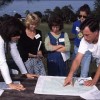 A result of the influx of new residents to the South is an expansion of urban areas into forests and other natural areas, creating areas referred to as the wildland-urban interface. Interface issues of most concern vary from state to state, but some key issues are consistent across the South. the US Forest Service conducted a series of focus groups in 2000. Key issues gleaned from those focus groups and other related sources are described in this 5-page fact sheet written by L. Annie Hermansen-Baez, Jennifer Seitz, and Martha C. Monroe, and published by the UF Department of School of Forest Resources and Conservation, February 2013.
A result of the influx of new residents to the South is an expansion of urban areas into forests and other natural areas, creating areas referred to as the wildland-urban interface. Interface issues of most concern vary from state to state, but some key issues are consistent across the South. the US Forest Service conducted a series of focus groups in 2000. Key issues gleaned from those focus groups and other related sources are described in this 5-page fact sheet written by L. Annie Hermansen-Baez, Jennifer Seitz, and Martha C. Monroe, and published by the UF Department of School of Forest Resources and Conservation, February 2013.
http://edis.ifas.ufl.edu/fr264
Tag: L. Annie Hermansen-Baez
Fire in the Wildland-Urban Interface: Selecting Firewise Shrubs to Reduce Wildfire Risk (FOR272/FR334)
 In areas with moderate to high risk of fire, shrubs may put your home at risk. This 10-page, full-color, illustrated guide presents 34 species organized by flammability, to help you select and place shrubs in your landscape to minimize the risk of wildfire. Written by Annie Hermansen-Baez, Wayne C. Zipperer, Alan J. Long, Anna L. Behm, Dawn McKinstry, and Anne Andreu, and published by the UF Department of School of Forest Resources and Conservation, July 2011.
In areas with moderate to high risk of fire, shrubs may put your home at risk. This 10-page, full-color, illustrated guide presents 34 species organized by flammability, to help you select and place shrubs in your landscape to minimize the risk of wildfire. Written by Annie Hermansen-Baez, Wayne C. Zipperer, Alan J. Long, Anna L. Behm, Dawn McKinstry, and Anne Andreu, and published by the UF Department of School of Forest Resources and Conservation, July 2011.
http://edis.ifas.ufl.edu/fr334
FOR225/FR287 Wildland Urban Interface: Varied Definitions
FOR225, a 4-page illustrated fact sheet by L. Annie Hermansen-Baez, Jennifer Seitz, and Martha C. Monroe, describes several common definitions of the WUI to assist natural resource professionals with new challenges and opportunities in the wildland-urban interface. Includes references. Published by the UF Department of Wildlife Conservation and Ecology, July 2009.
http://edis.ifas.ufl.edu/FR287
FOR202/FR264 Wildland-Urban Interface: Key Issues
FOR-202, a 6-page fact sheet by L. Annie Hermansen-Baez, Jennifer Seitz, and Martha C. Monroe, describes key issues gleaned from a series of focus groups conducted by the U.S. Forest Service in 2000, and other related sources. Includes references. Published by the UF School of Forest Resources and Conservation, October 2008.
http://edis.ifas.ufl.edu/FR264